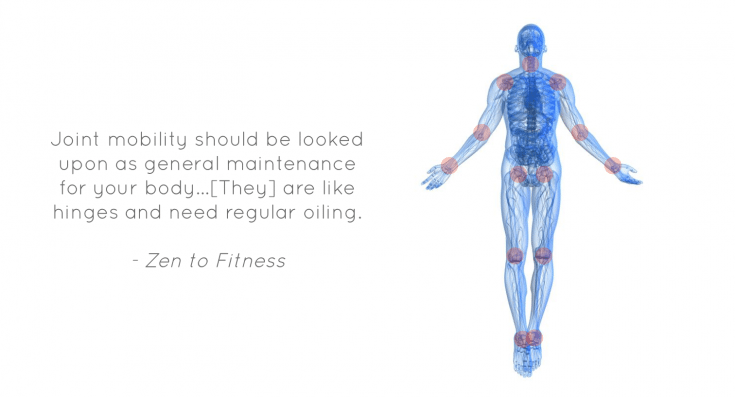Don't Mindlessly Stretch, but Mobilize with intent

I didn't truly learn what mobility
was until earlier this year.
We might know that stretching and foam rolling can be a part of mobility, or that the WOD has a prescribed warm up including mobility, but like with lifting weights mobility exercises must be done with specific intent.
While flexibility is the extension and expansion of the range of motion of a joint, in the fitness world mobility is the expression of strength throughout that range of motion .
I cringe when I see someone sitting and stretching their hamstring for an extended period before going on to do weight lifting or explosive exercises. Static stretching is best done several hours after your workout, or right before bed. It is more to do mobility exercises like active stretching or stretching with a distraction (like a band pulling in the opposite direction of the stretch). This type of stretching keeps muscles active throughout the range of motion. Active stretching can help you with joint recovery, injury prevention, better performance gains, and improved/more efficient range of motion.
Doing certain mobility exercises can help you recover from daily aches and pains as well as injuries. Recently, a client came to me with chronic shoulder pain and in two half-hour coaching sessions, we were able to relieve his pain. How? I handed him a lacrosse ball and told him to get to work. While there are pain disorders and injuries that cannot be addressed with mobility, there are also many instances when tight muscles are the reason for the chronic pain and mobility movements are both appropriate and helpful.
http://youtu.be/3aI2ie7VpLA?t=25s
It’s important to see a doctor or other professional to find out what is actually wrong, especially if your injury is severe, but strained or pulled muscles can likely be addressed with foam rolling, compression, rolling with a lacrosse ball or supernova, and specific stretches.
Just like nutrition, mobility plays a big role when it comes to your weight loss, strength, performance, and fitness goals. Mobilizing before a workout (foam rolling or ball rolling) will help warm up the muscles that you plan on using and bring blood flow to the area. It can also help correct postural issues, all of which are important when it comes to injury prevention and improved performance.
By adding in a post-workout mobility exercise routine, you can help heal muscle tissues more quickly, which in turn can speed up the recovery process. This may allow you to safely take fewer rest days, speeding your progress. Mobility exercises are also a great way to take an active recovery day-- where you don’t do any intense activity, but you still burn calories and use stabilizing muscles to support your weight while you are loosening up your muscles.
Proper form while performing exercises is vital. If you've spent any real amount of time at the gym, you’ve probably noticed some suspect squats, rows, and military presses. Often poor form occurs simply from a lack of knowledge, but sometimes our joints just can’t get into a proper position. Having the necessary flexibility within the joint(s) for the proper range of motion for the exercise is essential.

Take such as the squat. Tightness in the hips can make it difficult to push your knees out to achieve the proper form. Tight hamstrings can also make the bottom portion of a squat difficult to do properly, and it often results in what’s referred to as a “butt wink”-- where your butt pulls underneath you at the bottom of a squat. Additionally, under active glutes or a tight low back can result in overarching. All of this can result in a serious injury. However, they can all be addressed with simple mobility exercises.
Identifying what muscles are tight, what joints are lacking proper range of motion, and how to fix these problems is a huge step towards better performance, more consistent results, and fewer injuries.
[divider]

Andi Singer works as a writer for an HMR diet company called IHM Online , and as a strength and weight loss coach. Over the last five years she has lost more than 60lbs and found a love for Thai fighting, power-lifting, and all things mobility. You can contact her via Twitter , Google+ , or Instagram.
We might know that stretching and foam rolling can be a part of mobility, or that the WOD has a prescribed warm up including mobility, but like with lifting weights mobility exercises must be done with specific intent.
While flexibility is the extension and expansion of the range of motion of a joint, in the fitness world mobility is the expression of strength throughout that range of motion .
Mobility is dynamic just like our lifestyles
I cringe when I see someone sitting and stretching their hamstring for an extended period before going on to do weight lifting or explosive exercises. Static stretching is best done several hours after your workout, or right before bed. It is more to do mobility exercises like active stretching or stretching with a distraction (like a band pulling in the opposite direction of the stretch). This type of stretching keeps muscles active throughout the range of motion. Active stretching can help you with joint recovery, injury prevention, better performance gains, and improved/more efficient range of motion.
Mobility for Recovery
Doing certain mobility exercises can help you recover from daily aches and pains as well as injuries. Recently, a client came to me with chronic shoulder pain and in two half-hour coaching sessions, we were able to relieve his pain. How? I handed him a lacrosse ball and told him to get to work. While there are pain disorders and injuries that cannot be addressed with mobility, there are also many instances when tight muscles are the reason for the chronic pain and mobility movements are both appropriate and helpful.
http://youtu.be/3aI2ie7VpLA?t=25s
It’s important to see a doctor or other professional to find out what is actually wrong, especially if your injury is severe, but strained or pulled muscles can likely be addressed with foam rolling, compression, rolling with a lacrosse ball or supernova, and specific stretches.
 Stay on Track with Weight Loss and Strength Goals
Stay on Track with Weight Loss and Strength Goals
Just like nutrition, mobility plays a big role when it comes to your weight loss, strength, performance, and fitness goals. Mobilizing before a workout (foam rolling or ball rolling) will help warm up the muscles that you plan on using and bring blood flow to the area. It can also help correct postural issues, all of which are important when it comes to injury prevention and improved performance.
By adding in a post-workout mobility exercise routine, you can help heal muscle tissues more quickly, which in turn can speed up the recovery process. This may allow you to safely take fewer rest days, speeding your progress. Mobility exercises are also a great way to take an active recovery day-- where you don’t do any intense activity, but you still burn calories and use stabilizing muscles to support your weight while you are loosening up your muscles.
Keep Your Joints Safe
Proper form while performing exercises is vital. If you've spent any real amount of time at the gym, you’ve probably noticed some suspect squats, rows, and military presses. Often poor form occurs simply from a lack of knowledge, but sometimes our joints just can’t get into a proper position. Having the necessary flexibility within the joint(s) for the proper range of motion for the exercise is essential.

Take such as the squat. Tightness in the hips can make it difficult to push your knees out to achieve the proper form. Tight hamstrings can also make the bottom portion of a squat difficult to do properly, and it often results in what’s referred to as a “butt wink”-- where your butt pulls underneath you at the bottom of a squat. Additionally, under active glutes or a tight low back can result in overarching. All of this can result in a serious injury. However, they can all be addressed with simple mobility exercises.
Identifying what muscles are tight, what joints are lacking proper range of motion, and how to fix these problems is a huge step towards better performance, more consistent results, and fewer injuries.
[divider]
Author Bio:

Andi Singer works as a writer for an HMR diet company called IHM Online , and as a strength and weight loss coach. Over the last five years she has lost more than 60lbs and found a love for Thai fighting, power-lifting, and all things mobility. You can contact her via Twitter , Google+ , or Instagram.




































































































